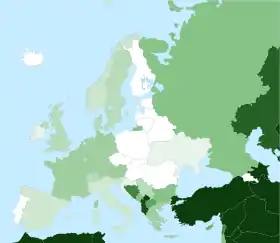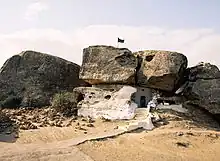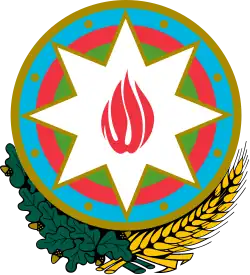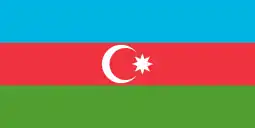
| 90–100% | |
| 70–90% | |
| 50–70% | Bosnia and Herzegovina |
| 30–40% | North Macedonia |
| 10–20% | |
| 5–10% | |
| 4–5% | |
| 2–4% | |
| 1–2% | |
| < 1% |
| Islam by country |
|---|
 |
|
|
| Part of a series on |
| Azerbaijanis |
|---|
| Culture |
| Traditional areas of settlement |
| Diaspora |
| Religion |
| Language |
| Persecution |
mosque_XVII.jpg.webp)

Islam is the majority religion in Azerbaijan, but the country is considered to be the most secular in the Muslim world.[2] Various reports have estimated 97.3% (CIA, 2020)[3] or 99.2% (Pew Research Center, 2006)[4] of the population identifying as Muslim; with the majority being adherents of the Shia branch (55-85%), while a significant minority (15-45%) are Sunnis.[5][6][3][7] Traditionally, the differences between these two branches of Islam have not been sharply defined in Azerbaijan.
Most Shia Muslims in the country follow the Ja'fari school of Shia Islam, while Sunni Muslims typically adhere to either the Hanafi or Shafi'i school.[8] Due to many decades of Soviet atheist policy, religious affiliation in Azerbaijan is often nominal and Muslim identity tends to be based more on culture and ethnicity than on religion. Shia Islam is prevalent in the western, central, and southern regions of the country. Traditionally, villages around Baku and the Lankaran region are considered Shia strongholds. In contrast, Sunni Islam is dominant in the northern regions.[8]
History
Islam arrived in Azerbaijan with Arabs in the seventh century, gradually supplanting Christianity and pagan cults.[9]
In the sixteenth century, the first shah of the Safavid Dynasty, Ismail I (r. 1486-1524), established Shi'a Islam as the state religion,[9] although a portion of people remained Sunni. The population of what is nowadays Iran and what is nowadays Azerbaijan were converted to Shia Islam at the same moment in history.[10]
As elsewhere in the Muslim world, the two branches of Islam came into conflict in Azerbaijan.[9] Enforcement of Shi'a Islam as the state religion brought contention between the Safavid rulers and the ruling Sunnis of the neighboring Ottoman Empire.[9]
In the nineteenth century, many Sunni Muslims emigrated from Russian-controlled Azerbaijan because of Russia's series of wars with their coreligionists in the Ottoman Empire.[9] Thus, by the late nineteenth century, the Shi'a population was in the majority in Russian Azerbaijan.[9] Antagonism between the Sunnis and the Shi'a diminished in the late nineteenth century as Azerbaijani nationalism began to emphasize a common Turkic heritage and opposition to Iranian religious influences.[9]
Russian Empire and Soviet Union
| Islam by country |
|---|
 |
|
|
In 1806, Azerbaijan became occupied by the Russian Empire as the latter invaded Qajar Iran during the Russo-Persian War (1804-1813). In the aftermath, Iran was forced to cede therefore almost all of Azerbaijan according to the Treaty of Gulistan of 1813 to Russia. However, all this only came to be confirmed in the aftermath of the next and last war between Russia and Iran, the Russo-Persian War (1826-1828) and the resulting Treaty of Turkmenchay of 1828. In 1918, Azerbaijan declared independence from Russia and established the Azerbaijan Democratic Republic under its leading Musavat party, but was incorporated into the Soviet Union in 1920.
Before Soviet power was established, about 2,000 mosques were active in Azerbaijan.[9] Most mosques were closed in the 1930s, then some were allowed to reopen during World War II.[9] The Soviet rule promoted an Azerbaijani national consciousness as a substitute for identification with the world Islamic community and Iran.[11][12]
During World War II, Soviet authorities established the Muslim Spiritual Board of Transcaucasia in Baku as the governing body of Islam in the Caucasus, in effect reviving the nineteenth-century tsarist Muslim Ecclesiastical Board.[9] During the tenures of Leonid Brezhnev and Mikhail Gorbachev, Moscow encouraged Muslim religious leaders in Azerbaijan to visit and host foreign Muslim leaders, with the goal of advertising the freedom of religion and superior living conditions reportedly enjoyed by Muslims under Soviet communism.[9]
During the Azerbaijani SSR, there were 17 mosques functioning in the country. In the 1980s only two large and five smaller mosques held services in Baku, and only eleven others were operating in the rest of the country.[9] Supplementing the officially sanctioned mosques were thousands of private houses of prayer and many secret Islamic sects.[9]
The lone center of conservative Shia Islam, was the town of Nardaran, 25 kilometers northeast of central Baku, and was renowned for its thirteenth-century Shia shrine. Unlike the rest of the country which was staunchly secular and which can be considered religiously progressive, Nardaran was the only place in the whole of Azerbaijan where its inhabitants are devoutly religious and fundamentalist, where its streets display religious banners and where most women wear chadors in public. The now banned Islamic Party of Azerbaijan was founded in this town and its base was centered there.
There is some evidence of Sufism in Azerbaijan.[13]
After the Soviet Union


Beginning in the late Gorbachev period, and especially after independence, the number of mosques rose dramatically.[9] Many were built with the support of other Islamic countries, such as Iran, Oman, and Saudi Arabia, which also contributed Qur'ans and religious instructors to the new Muslim states.[9] A Muslim seminary has also been established since 1991.[9] The growing number of religious Muslims resulted in the establishment of more than 2,000 mosques by 2014.
After independence, the laws regarding religion are quite clear. In Article 7 of the constitution, Azerbaijan is declared a secular state. This point is driven home in Article 19 with the statement of the separation of religion and state and the equality of all religions before the law as well as the secular character of the state educational system.
Religiosity levels
Azerbaijan has been a secular country and is often considered the most secularized Muslim-majority nation.[14]
A 1998 survey estimated the proportion of ardent believers in Azerbaijan at close to 7 percent, slightly more than the number of declared atheists — almost 4 percent — with the largest numbers falling into the category of those who consider Islam above all as a way of life, without strict observance of prohibitions and requirements, or as a fundamental part of national identity.[15] Another 1998 poll estimated the proportion of ardent believers in Azerbaijan at only 20 percent.[16]
In a 2010 survey only half of Azerbaijanis answering yes to the question, "Is religion an important part of your daily life?".[17]
Yet in 2017 Dobroslawa Wiktor-Mach noted an Islamic revival in the country: In 2010, the Caucasus Research Resource Center (CRRC)'s "Caucasus Barometer" found out that for around 25% of the citizens religion was "very important" and for 43% "rather important" but just two years later, in 2012, as per the same organization those who considered it "very important" rose to 33% while those who chose "rather important" rose to 47% (16% selecting "less important", 2% not important and 1% not knowing.)[18]
Radical Islam
There is a certain rise of religious extremism across Azerbaijan as a result of continued problems such as corruption, poverty, and government rule, combined with disillusionment with the West and support of religious sects from different countries.[19][20][21][22] However it works against a headwind of traditional secularism. According to Svante Cornell:
Azerbaijan can rightly claim to be among the most progressive and secular Islamic societies. Aside from having been the first Muslim country to have operas, theater plays, and a democratic republic, Azerbaijan today is among the Muslim countries where support for secularism is the highest, and where radical ideologies have met only very limited interest.[14]
Svante Cornell believes that the radical groups remain weak, but have a potential to grow under the current domestic and international circumstances. To confront this, the Azerbaijani state needs to address the diarchy in terms of supervision of religious structures.[14] He writes, that the Government policies toward Islam in general and Islamic radicalism in particular have been inadequate.[14]
According to researchers Emil Souleimanov and Maya Ehrmann, there is "a trend among Dagestani minorities in the north of Azerbaijan to engage in insurgent activities". The Salafi movement has been "spurred by missionary activities using external funds and the establishment of mosques", and found support from those who the desire a return to more traditionalist values. As authorities have repressed Salafis in the north they have become more radical.[23]
Citizens of Azerbaijan have joined terrorist organizations in Syria.[24][25]
In Nardaran, a deadly incident broke out between Azerbaijan security forces and religious Shia residents in which two policemen and four suspected Shia Muslim militants were killed.[26][27][28][29][30][31]
As a result of this incident, the Azerbaijani parliament passed laws prohibiting people with religious education received abroad to implement Islamic rites and ceremonies in Azerbaijan, as well as to preach in mosques and occupy leading positions in the country; as well as prohibiting the display of religious paraphernalia, flags and slogans, except in places of worship, religious centers and offices.[32] Ashura commemorations in public have also been banned.[33] The Azerbaijani government also passed a law to remove the citizenship of Azerbaijani citizens who fight abroad.[34]
See also
Further reading
- Bedford, Sofie (2009). Islamic activism in Azerbaijan: repression and mobilization in a Post-Soviet context (Ph.D.). Stockholm University.
- Collins, Kathleen (October 2007). "Ideas, networks, and Islamist movements: Evidence from Central Asia and the Caucasus". World Politics. 60 (1): 64–96. doi:10.1353/wp.0.0002. JSTOR 40060181. S2CID 145601429. Pdf.
- Cornell, Svante E. (October 2006). "The politicization of Islam in Azerbaijan". Central Asia-Caucasus Institute Silk Road Studies Program. Pdf.
- Dragadze, Tamara (1994), "Islam in Azerbaijan: The position of women", in Fawzi El-Solh, Camillia; Mabro, Judy (eds.), Muslim women's choices: Religious belief and social reality, Providence, Rhode Island New York: Berg Distributed in North America by New York University Press, pp. 152–163, ISBN 9780854968367.
- Karagiannis, Emmanuel (2010). "Political Islam in the former Soviet Union: Uzbekistan and Azerbaijan compared". Dynamics of Asymmetric Conflict, Pathways Toward Terrorism and Genocide. 3 (1): 46–61. doi:10.1080/17467586.2010.514937. S2CID 143621102.
- Motika, Raoul (July–September 2001). "Islam in Post-Soviet Azerbaijan". Archives de Sciences Sociales des Religions. 46 (115): 111–124. doi:10.4000/assr.18423. JSTOR 30127240.
- Sattarov, Rufat (2009). Islam, state, and society in independent Azerbaijan: between historical legacy and post-Soviet reality with special reference to Baku and its environs. Wiesbaden: Reichert. ISBN 9783895006920. Online
- Tohidi, Nayereh (January–April 1996). "Soviet in public, Azeri in private: Gender, Islam, and nationality in Soviet and post-Soviet Azerbaijan". Women's Studies International Forum. 19 (1–2): 111–123. doi:10.1016/0277-5395(95)00074-7.
References
- ↑ "Religious Composition by Country, 2010-2050". Pew Research Center. 12 April 2015. Retrieved 22 October 2017.
- ↑ "Islam and Secularism: the Azerbaijani experience and its reflection in France". PR Web. Retrieved 2013-08-16.
- 1 2 "Middle East :: Azerbaijan — The World Factbook". Central Intelligence Agency. Retrieved 2023-07-09.
- ↑ "Interactive Data Table: World Muslim Population by Country". Pew Research Center. 7 October 2009. Retrieved 2020-08-09.
- ↑ "Religion" (PDF). Administrative Department of the President of the Republic of Azerbaijan – Presidential Library. Retrieved 2023-12-20.
- ↑
Sources:
- "2021 Report on International Religious Freedom: Azerbaijan". U.S Department of State. 2 June 2022. Archived from the original on 4 June 2022.
According to 2011 SCWRA data (the most recent available), 96 percent of the population is Muslim, of which approximately 65 percent is Shia and 35 percent Sunni.
- Greenger, Nurit (8 May 2017). "Azerbaijan a Destination Worthwhile. My week travel log in Azerbaijan - Day two". The Jerusalem Post. Archived from the original on 19 January 2023.
- Balci, Bayram (18 March 2013). "The Syrian Crisis: A View from Azerbaijan". Carnegie Endowment for International Peace. Archived from the original on 18 January 2022.
- Ismayilov, Murad (2018). "1: Hybrid Intentionality and Exogenus Sources of Elite's Manifold Attitudes to Islam in Azerbaijan". The Dialectics of Post-Soviet Modernity and the Changing Contours of Islamic Discourse in Azerbaijan. London SE11 4AB: Lexington Books. p. 2. ISBN 9781498568364.
the country's population historically divided between the Shia (currently some 50-65 percent of the population) and the Sunni (about 35-50 percent).
{{cite book}}: CS1 maint: location (link) - S. Nielsem, Jorgen; Balciz Goyushov, Bayram, Altay (2013). "Azerbaijan". Yearbook of Muslims in Europe: Volume 5. Leiden, The Netherlands: Brill. p. 65. ISBN 978-90-04-25456-5.
quote:"While traditionally approximately 65% of local Muslims are considered Shi'i and 35% Sunnis, due to a great success of international Sunni missionary organisations after the collapse of the Soviet Union, currently the estimated number of practicising Sunni and Shi'i Muslims in the big urban areas are almost equal"
{{cite book}}: CS1 maint: multiple names: authors list (link) - Whitaker's Shorts 2015: International. Bloomsbury. 2014. ISBN 9781472914842.
- "2021 Report on International Religious Freedom: Azerbaijan". U.S Department of State. 2 June 2022. Archived from the original on 4 June 2022.
- ↑ Mammadli, Nijat (7 June 2018). "Islam and Youth in Azerbaijan". Baku Research Institute. Archived from the original on 20 April 2023.
quote:"Also, according to rough estimates, Shiites constitute 60-65% of the Muslim population, and Sunnis – 35-40%."
- 1 2 Mammadli, Nijat (7 June 2018). "Islam and Youth in Azerbaijan". Baku Research Institute. Retrieved 20 April 2023.
- 1 2 3 4 5 6 7 8 9 10 11 12 13 14 15 16
 This article incorporates text from this source, which is in the public domain: Curtis, Glenn E. (1995). Armenia, Azerbaijan, and Georgia : country studies (1st ed.). Washington, D.C.: Federal Research Division. pp. 106–107. ISBN 0-8444-0848-4. OCLC 31709972.
This article incorporates text from this source, which is in the public domain: Curtis, Glenn E. (1995). Armenia, Azerbaijan, and Georgia : country studies (1st ed.). Washington, D.C.: Federal Research Division. pp. 106–107. ISBN 0-8444-0848-4. OCLC 31709972. - ↑ Akiner, Shirin (2004-07-05). The Caspian: politics, energy and security, By Shirin Akiner, pg.158. Taylor & Francis. ISBN 9780203641675. Retrieved 17 December 2014.
- ↑ Bournoutian, George A. (2016). The 1820 Russian Survey of the Khanate of Shirvan: A Primary Source on the Demography and Economy of an Iranian Province prior to its Annexation by Russia. Gibb Memorial Trust. p. ix. ISBN 978-1909724808.
In 1922 Soviet officials and local intellectuals, living in the newly-created republic of Soviet Azerbaijan, in order to reduce the influence of Islam and Iran, as well as to instill a much-needed national identity, introduced a Latin alphabet, similar to the new Latin alphabet created in Turkey for much the same reasons.
- ↑ Bournoutian, George (2018). Armenia and Imperial Decline: The Yerevan Province, 1900-1914. Routledge. pp. xiii–xiv.
In 1922, the Soviets, in order to reduce the influence of Islam and Iran as well as to instill a much-needed national identity, replaced the Arabo-Persian script used by the Muslims in the South Caucasus with a Latin alphabet (slightly modified in 1933), similar to the new Latin alphabet created in Turkey for much the same reason.
- ↑ ALESKEROVA, Nesrin (2007). "SUFISM IN AZERBAIJAN". CA & CC Press. Retrieved 24 May 2015.
- 1 2 3 4 "Svante E. Cornell. The Politicization of Islam in Azerbaijan" (PDF). Archived from the original (PDF) on 2013-04-18. Retrieved 2009-05-15.
- ↑ Tadeusz Swietochowski Azerbaijan: The Hidden Faces of Islam. World Policy Journal, Volume XIX, No 3, Fall 2002
- ↑ Fereydoun Safizadeh, "On Dilemmas of Identity in the Post-Soviet Republic of Azerbaijan," Caucasian Regional Studies, vol.3, no.1 (1998).
- ↑ Religiosity Highest in World's Poorest Nations August 31, 2010 - data accessed on 22 May 2015
- ↑ Wiktor-Mach, Dobroslawa (2017). Religious Revival and Secularism in Post-Soviet Azerbaijan. De Gruyter. pp. 92–93.
- ↑ "Azerbaijani Jews worried over increasing radical Islamists, By Amiram Barkat, Haaretz - 02.15.2006". Archived from the original on 2012-02-25. Retrieved 2009-10-31.
- ↑ "BBC NEWS - Europe - Azeri poverty fuels rise of Islam". Retrieved 22 March 2015.
- ↑ "Home".
- ↑ Fuller, Liz (8 April 2008). "Azerbaijan: Does Wahhabism Pose A Threat?". RadioFreeEurope/RadioLiberty. Retrieved 22 March 2015.
- ↑ Souleimanov, Emil; Ehrmann, Maya (Fall 2013). "The Rise of Militant Salafism in Azerbaijan and Its Regional Implications". Middle East Policy Council. XX (3). Retrieved 24 May 2015.
- ↑ "The Clear Banner: The Forgotten Fighters: Azerbaijani Foreign Fighters in Syria and Iraq". JIHADOLOGY. Retrieved 25 October 2015.
- ↑ "GUEST POST: Azerbaijani Foreign Fighters in Syria". JIHADOLOGY. Retrieved 25 October 2015.
- ↑ "Рамиль Усубов: В связи с событиями в Нардаране арестованы 32 человека – ВИДЕО". 2 December 2015.
- ↑ "Дороги в Нардаран перекрыты бетонными плитами - [ВИДЕО]". Archived from the original on 2015-12-27. Retrieved 2015-12-26.
- ↑ "Ситуация в Нардаране остается напряженной". Archived from the original on 2015-12-27. Retrieved 2015-12-26.
- ↑ "МВД сообщает, что в доме Э.Гасымова обнаружено оружие". Archived from the original on 2016-03-04. Retrieved 2015-12-26.
- ↑ "Тела убитых в Нардаране выданы родным" [The bodies of those killed in Nardaran were handed over to their relatives]. Кавказский узел [Caucasian Knot] (in Russian). December 5, 2015. Retrieved 2022-03-23.
- ↑ "RUSSIA TO REDIRECT MASSIVE OIL VOLUMES FROM DRUZHBA TO BALTIC PIPELINE | the Jamestown Foundation". Archived from the original on 2016-02-13. Retrieved 2010-04-05.[tt_news]=44846&cHash=c3ba7363d698036659ab0e10c671aeaf
- ↑ "В Азербайджане запретят мулл, обучавшихся за границей (Azerbaijan has banned mullahs studying abroad)" (in Russian). Oxu.az. 2 December 2015.
- ↑ "В Азербайджане запрещают различные представления в дни Ашура (Azerbaijan will forbid various representations in the days of Ashura)" (in Russian). Oxu.az. 2 December 2015.
- ↑ "Террористов будут лишать азербайджанского гражданства (Terrorists will be deprived Azerbaijani citizenship)" (in Russian). Oxu.az. 2 December 2015.
Notes
Further reading
- Bashirov, Galib (2020). "The Politics of the Hijab in Post-Soviet Azerbaijan". Nationalities Papers. 48 (2): 357–372. doi:10.1017/nps.2018.81. S2CID 212928375.
External links
- ISLAMIC AND ETHNIC IDENTITIES IN AZERBAIJAN: EMERGING TRENDS AND TENSIONS, A Discussion Paper, by Hema Kotecha, OSCE, 2006 Archived 2009-03-05 at the Wayback Machine
- Azerbaijan: Islam in a post-soviet republic. By Anar Valiyev, CAEI
- Azerbaijan: Islamic threat to religious harmony, Open Democracy News Archived 2016-03-05 at the Wayback Machine

